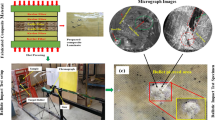Abstract
This study explores the effects of modified (OMMT) nanoclay and core material on low velocity impact behavior and damage tolerance capability of glass fiber reinforced (FRP) polyester resin – polystyrene foam (PS) sandwich laminates. The FRP and sandwich laminates are prepared by a compression molding technique for investigation. Low velocity impacts are carried out on all the fabricated laminates by using a instrumented drop weight impact tower with the energy level of 30 J and load–energy–time plots were recorded using data acquisition software. Post impact flexural tests have been conducted to evaluate the damage tolerance capability of the fabricated composite laminates. X-ray Diffraction (XRD) results have been obtained for the samples, where the nanoclay has indicated that intergallery spacing of the layered clay increases with the matrix. Scanning Electron Microscopy (SEM) has given the morphological picture of the nanoclay dispersion in the polymer fracture samples. The results of the study show that the impact properties and damage tolerance capability of the 4% nanoclay polyester sandwich have been greatly increased.
Similar content being viewed by others
References
Shahid N, Villate R G, Baron A R (2005) Chemically functionalized alumina nanoparticle effect on carbon fiber/epoxy composites. Compos Sci Technol 27:1123–31
Chieruzzi M, Miliozzi A, Kenny JM (2013) Effects of the nanoparticles on the thermal expansion and mechanical properties of unsaturated polyester/clay nanocomposites. Compos Part A 45:44–48
Xu L, Lee LJ (2004) Effect of nanoclay on shrinkage control of low profile unsaturatedPolyester (UP) resin cured at room temperature. Polymer 45:7325–7334
Jawahar P, Gnanamoorthy R, Balasubramanian M (2006) Tribological behaviour of clay – thermoset polyester nanocomposites. Wear 261:835–840
Chan M-l, Lau K-t, Wong T-t, Ho M-p, Hui D (2011) Mechanism of reinforcement in a nanoclay/polymer composite. Compos Part B 42:1708–1712
Suresha B, Devarajaiah R M, Pasang T, Ranganathaiah C (2013) Investigation of organo-modified montmorillonite loading effect on the abrasion resistance of hybrid composites. Mater Des 47:750–758
Anbusagar N R R, Giridharan P, Palanikumar K (2013) Influence of nano particle on flexural and impact properties of sandwich structures. Adv Mater Res 602:174–177
Haque A, Shamsuzzoha M, Hussain F, Dean D (2003) S2-glass/epoxy polymer nanocomposites: manufacturing, structures, thermal and mechanical properties. J Compos Mater 37:1821
Avila AF, Soares MI, Neto AS (2007) A study on nanostructured laminated plates behavior under low-velocity impact loadings. Int J Impact Eng 34:28–41
Anbusagar N R R, Giridharan PK, Palanikumar K (2012) Mechanical behavior of glass-jute sandwich nano polyester composites to flexural and impact loading. Eur J Sci Res 84:148–155
Hosur MV, Mohammed AA, Zainuddin S, Jeelani S (2008) Impact performance of nanophased foam core sandwich composites. Mater Sci Eng A 498:100–109
Reis P NB, Ferreira J A M, Zhang ZY, Benameur T, Richardson M O W (2013) Impact response of Kevlar composites with nanoclay enhanced epoxy matrix. Compos Part B 46:7–14
Ávila AF, Carvalho MGR, Dias EC, da Cruz DTL (2010) Nano-structured sandwich composites response to low-velocity impact. Compos Struct 92:745–751
Anbusagar N R R, Giridharan P, Palanikumar K (2013) Effect of nano modified polyester resin on hybrid sandwich laminates. Mater Des 54:507–514
Sarasini F, Tirillò J, Valente M, Valente T, Cioffi S, Sorrentino L (2013) Effect of basalt fiber hybridization on the impact behavior under low impact velocity of glass/basalt woven fabric/epoxy resin composites. Compos Part A 47:109–123
Sabeel Ahmed K, Vijayarangan S, Rajput C (2006) Mechanical behavior of isothalic polyester-based untreated woven jute and glass fabric hybrid composites. J Reinf Plast Compos 25:1549–1569
Zhang D, Sun Y, Chen L, Pan N (2013) A comparative study on low-velocity impact response of fabric composite laminates. Mater Des 50:750–756
Ghasemi Nejhad M N, Parvizi-Majidi A (1990) Impact behavior and damage tolerance of woven carbon fiber-reinforced thermoplastic composites. Composites 21:155–168
Shyr T W, Pan Y H (2003) Impact resistance and damage characteristics of composite laminates. Compos Struct 62:193– 203
Anbusagar N R R, Palanikumar K, Giridharan P K (2015) Study of sandwich effect on nanoclay modified polyester resin GFR face sheet laminates. Compos Struct 125:336–342
Bledzki A K, Mamun A A, Faruk O (2007) Abaca fiber reinforced PP composites and comparison with jute and flax fiber PP composites. Express Polym Lett 1:755–62
Belingardi G, Cavatorta M P, Paolino D S (2008) Repeated impact response of hand layup and vacuum infusion thick glass reinforced laminates. Int J Impact Eng 35:609–19
Benevolenski O I, Karger-Kocsis J, Mieck K -P, Reubmann T (2000) Instrumented perforation impact response of polypropylene composites with hybrid reinforcement flax/glass and flax/cellulose fibers. J Thermoplast Compos Mater 13:481– 96
Belingardi G, Vadori R (2002) Low velocity impact tests of laminate glass–fiber–epoxy matrix composite material plates. Int J Impact Eng 27:213–29
Author information
Authors and Affiliations
Corresponding author
Rights and permissions
About this article
Cite this article
R. Anbusagar, N.R., Palanikumar, K. Nanoclay Addition and Core Materials Effect on Impact and Damage Tolerance Capability of Glass Fiber Skin Sandwich Laminates. Silicon 10, 769–779 (2018). https://doi.org/10.1007/s12633-016-9529-2
Received:
Accepted:
Published:
Issue Date:
DOI: https://doi.org/10.1007/s12633-016-9529-2




